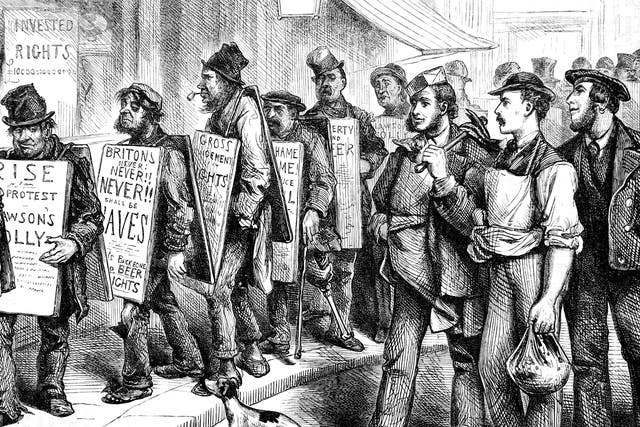Freedom of Speech
 sale of alcohol in the united states of America.Illustration showing a demonstration against restrictions on the sale of alcohol in the united states of America 1875. (Photo by: Universal History Archive/Universal Images Group via Getty Images)" width="" height="" />
sale of alcohol in the united states of America.Illustration showing a demonstration against restrictions on the sale of alcohol in the united states of America 1875. (Photo by: Universal History Archive/Universal Images Group via Getty Images)" width="" height="" />
Freedom of speech—the right to express opinions without government restraint—is a democratic ideal that dates back to ancient Greece. In the United States, the First Amendment guarantees free speech, though the United States, like all modern democracies, places limits on this freedom. In a series of landmark cases, the U.S. Supreme Court over the years has helped to define what types of speech are—and aren’t—protected under U.S. law.
The ancient Greeks pioneered free speech as a democratic principle. The ancient Greek word “parrhesia” means “free speech,” or “to speak candidly.” The term first appeared in Greek literature around the end of the fifth century B.C.
During the classical period, parrhesia became a fundamental part of the democracy of Athens. Leaders, philosophers, playwrights and everyday Athenians were free to openly discuss politics and religion and to criticize the government in some settings.
First Amendment
In the United States, the First Amendment protects freedom of speech.
The First Amendment was adopted on December 15, 1791 as part of the Bill of Rights—the first ten amendments to the United States Constitution. The Bill of Rights provides constitutional protection for certain individual liberties, including freedoms of speech, assembly and worship.
The First Amendment doesn’t specify what exactly is meant by freedom of speech. Defining what types of speech should and shouldn’t be protected by law has fallen largely to the courts.
In general, the First Amendment guarantees the right to express ideas and information. On a basic level, it means that people can express an opinion (even an unpopular or unsavory one) without fear of government censorship.
It protects all forms of communication, from speeches to art and other media.
Freedom of Speech
Flag Burning
While freedom of speech pertains mostly to the spoken or written word, it also protects some forms of symbolic speech. Symbolic speech is an action that expresses an idea.
Flag burning is an example of symbolic speech that is protected under the First Amendment. Gregory Lee Johnson, a youth communist, burned a flag during the 1984 Republican National Convention in Dallas, Texas to protest the Reagan administration.
The U.S. Supreme Court, in 1990, reversed a Texas court’s conviction that Johnson broke the law by desecrating the flag. Texas v. Johnson invalidated statutes in Texas and 47 other states prohibiting flag burning.
When Isn’t Speech Protected?
Not all speech is protected under the First Amendment.
Forms of speech that aren’t protected include:
- Obscene material such as child pornography
- Plagiarism of copyrighted material
- Defamation (libel and slander)
- True threats
Speech inciting illegal actions or soliciting others to commit crimes aren’t protected under the First Amendment, either.
The Supreme Court decided a series of cases in 1919 that helped to define the limitations of free speech. Congress passed the Espionage Act of 1917, shortly after the United States entered into World War I. The law prohibited interference in military operations or recruitment.
Socialist Party activist Charles Schenck was arrested under the Espionage Act after he distributed fliers urging young men to dodge the draft. The Supreme Court upheld his conviction by creating the “clear and present danger” standard, explaining when the government is allowed to limit free speech. In this case, they viewed draft resistant as dangerous to national security.
American labor leader and Socialist Party activist Eugene Debs also was arrested under the Espionage Act after giving a speech in 1918 encouraging others not to join the military. Debs argued that he was exercising his right to free speech and that the Espionage Act of 1917 was unconstitutional. In Debs v. United States the U.S. Supreme Court upheld the constitutionality of the Espionage Act.
Freedom of Expression
The Supreme Court has interpreted artistic freedom broadly as a form of free speech.
In most cases, freedom of expression may be restricted only if it will cause direct and imminent harm. Shouting “fire!” in a crowded theater and causing a stampede would be an example of direct and imminent harm.
In deciding cases involving artistic freedom of expression the Supreme Court leans on a principle called “content neutrality.” Content neutrality means the government can’t censor or restrict expression just because some segment of the population finds the content offensive.
Free Speech in Schools
In 1965, students at a public high school in Des Moines, Iowa, organized a silent protest against the Vietnam War by wearing black armbands to protest the fighting. The students were suspended from school. The principal argued that the armbands were a distraction and could possibly lead to danger for the students.
The Supreme Court didn’t bite—they ruled in favor of the students’ right to wear the armbands as a form of free speech in Tinker v. Des Moines Independent School District. The case set the standard for free speech in schools. However, First Amendment rights typically don’t apply in private schools.

 sale of alcohol in the united states of America.Illustration showing a demonstration against restrictions on the sale of alcohol in the united states of America 1875. (Photo by: Universal History Archive/Universal Images Group via Getty Images)" width="" height="" />
sale of alcohol in the united states of America.Illustration showing a demonstration against restrictions on the sale of alcohol in the united states of America 1875. (Photo by: Universal History Archive/Universal Images Group via Getty Images)" width="" height="" />